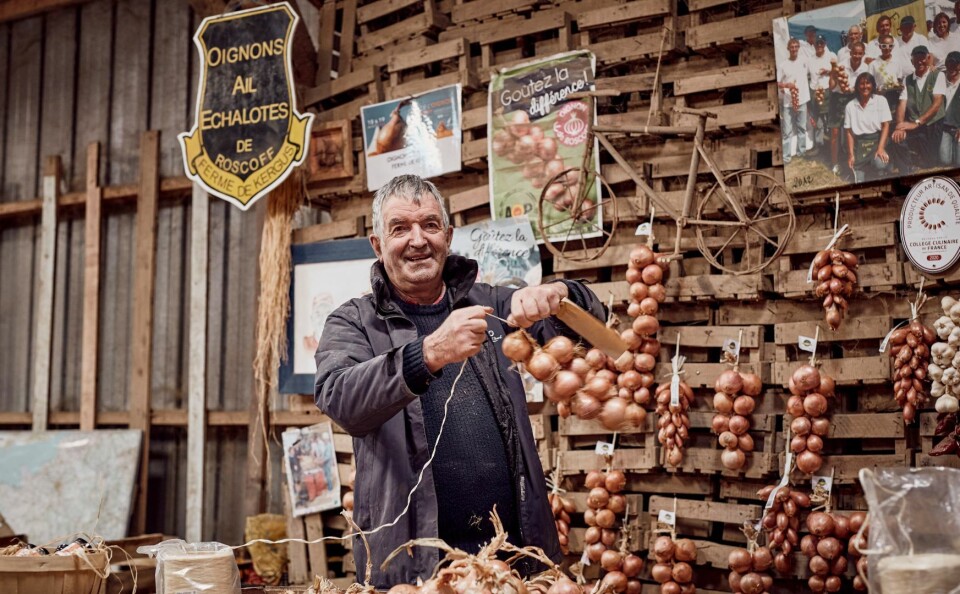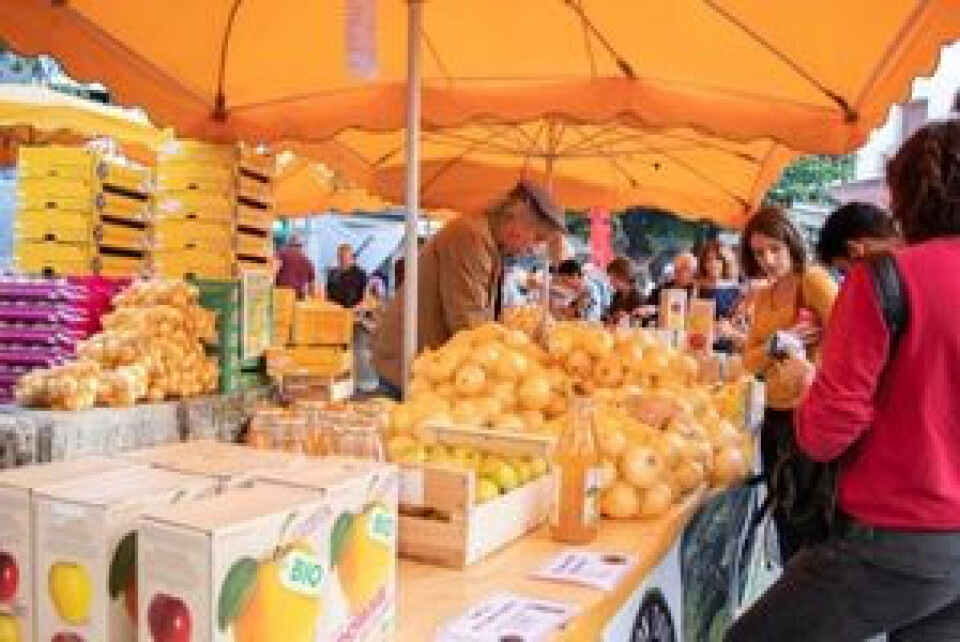-
The origins and meaning of tirer les marrons du feu
As Christmas approaches, we look at a phrase to describe someone who takes advantage of a situation
-
Recipe: Corsican fiadone cheesecake
This easy-to-make cake is a traditional crowd-pleasing dessert
-
Recipe: Flemish beef and beer stew
This hearty dish featuring French pain d’épice (spice bread) and gnocchi is sure to warm you up during the cold winter months
The onion - flavours, dishes and festivals to celebrate a French icon
From Brittany to Provence, we explore the tradition, history and culture of onions in France

Onions are so French they ought to be red, white and blue when you cut into them.
They feature heavily in traditional French cooking and crop up in salads, pizzas and, of course, the iconic French onion soup. But not all onions are created equal.
Peel a few layers off the subject and you will discover the delights of a whole host of different types of onions.
In fact, onions are such a passion that many places in France hold whole festivals devoted to them.
Depending on their variety, onions are harvested any time between June and September, meaning there are local onion festivals all over France throughout the summer.
If you don’t know your (French) onions already, visiting these gastronomic celebrations is an excellent education.
Read more: ‘S’occuper de ses oignons’ and other onion-related phrases
Read more: MAP: A tour of France by local fruits and vegetables
Remembering the Onion Johnnies
Roscoff, in Brittany, is home to the Onion Johnnies, onion producers who used to spend almost half the year cycling around the UK on bicycles festooned with strings of onions, selling door to door.
Often wearing stripy jumpers and berets to attract attention, their style became synonymous with all Frenchmen.
A few Onion Johnnies continued selling their produce in the UK right into this century, driving vans full of onions over to the UK for a few weeks at a time, but the combination of Covid and Brexit finished the tradition.
Read more: Brexit and Covid mean the last true French Onion Johnnies have gone
The small museum La Maison des Johnnies et de l’Oignon de Roscoff tells the whole story, and is well worth a visit.
There is information on traditional cultivation techniques, and they also have some amazing photographs and old film of the Johnnies, shot both in France and the UK, but be warned that everything is in French.
Wandering round the beautiful historic centre with its half-timbered houses, don’t miss the lighthouse, a square-shaped, red-brick tower right at the edge of the harbour.
The Eglise Notre-Dame de Croaz Batz, with its suspended boats, is also fascinating.
Why Roscoff onions are special
Onions grown in Roscoff are sweet and mellow, pinkish outside and white inside.
The story goes that a single seed was originally brought back from Lisbon by a monk who planted it at the convent.
Today, Roscoff onions have AOC and AOP status and the annual festival held to celebrate the harvest is one of the largest in the area.
The Fête de l’Oignon de Roscoff is held over an entire weekend at the end of August and is probably the largest onion festival in France.
There are numerous stands selling onions, and workshops where visitors learn to plait them into traditional strings.
There is a display of vintage tractors and farm machinery, a treasure hunt, cooking demonstrations, a parade, face painting, music, food, and a host of amusements for children.
Sandy beaches of Roscoff
While in Roscoff, don’t miss the Ile de Batz. A 15-minute boat ride from the main harbour, it feels like a world away.
The 12km walk around the island is a very well-marked, easy stroll, or you can hire bicycles.
The sandy beaches are stunning. Out of season, you might want to consider a picnic as many of the restaurants are closed.
The Jardin Georges Delaselle is worth seeing, with its collection of exotic flora from around the world. There is another fabulous park, the Jardin Exotique et Botanique, which feels like you are in the Caribbean.
This mild onion can be eaten raw like an apple
The Saint-Turjan onion, which is often nicknamed the Rosé des Sables, was traditionally grown on the Ile d’Oléron, off the Poitou-Charentes coast. With its pink skin and very mild flavour, it can be eaten raw like an apple. It was hugely popular during the Belle Epoque.
Cultivation on the island, however, was progressively abandoned as oyster farming and tourism became more profitable, until a local association was set up in 2019 to preserve the legacy.
The Association Le Saint-Turjan encourages people to cultivate this variety of onion, and the seeds are available online.
Saint-Turjan onions can be bought at the markets on the island. There are many, so ask at the tourist office for details.
The largest is the Château d’Oléron which is open every morning except Mondays.
As well as onions, look for fresh seafood, especially oysters and mussels, and try the local Pineau des Charentes, which is a fortified wine made from grape juice and Cognac eau-de-vie.
Grown in the mountainous Cévennes, south-central France
Another very mild variety is the Oignon Doux des Cévennes which is pearly white and slightly elongated. Marketed with the slogan “as good raw as cooked”, it is often used in salads.
Its origins can be traced back to the 15th century, but it only became really well-known during the 1950s.
It now has AOC and AOP status and is the only French onion grown on terraces carved across the mountain sides. Most of the production is still carried out by hand.
The Foire de la Pomme et de l’Oignon is held on the fourth Sunday of October in the sleepy market town of Le Vigan, in the Gard.
The festival attracts thousands of visitors who come to buy apples and onions, see demonstrations of vintage farm machinery, and stroll around the 90-odd stands selling all sorts of local produce, Pélardon cheese and chestnuts in particular.

Foire de la Pomme et de l’Oignon in Le Vigan; Photo: Samantha David
Attractions include a mini-farm, games and amusements for kids, a workshop on how to select onions, music, dancing and large meals in the market square.
Sweetest onions are in Aude
However sweet the Cévennes onions can be, aficionados swear that the Citou of Occitanie is even sweeter.
The tiny village of Citou (Aude) goes all out every September. This year the festival is on the 11th, featuring stands selling locally produced lamb and pork, charcuterie, goats’ cheeses, and honey as well as onions.
There will be music and gallons of onion soup.
Still in Occitanie, the Cèbe of Lèzignan has been grown around the village of Lézignan-la-Cèbe near Pézenas since the 17th century. (The Catalan for onion is ‘ceba’.)
Mild and juicy cèbes are white-skinned and flat, and can grow up to 10cm in diameter.
The Foire à l’Oignon Doux et Marché de Producteurs de Pays takes place in mid-July, featuring demonstrations of how to make them into bunches and strings, a competition for the biggest cèbe, tastings and an evening of parades, music, singing, dancing and celebrating.
Village rivalry near Carcassonne
Also look out for the red onions of Villemagne (north-west of Carcassonne), which are flat and red with pink flesh. Locals swear that they only taste sweet if grown in Villemagne.
They say that even if they are only cultivated a few miles away in another village, they have a much sharper flavour.
Oignons Doux de Villemagne are something of an insider secret. There is no fête, no festival, and no association.
They are only sold in local markets; track them down at Bram (Wednesdays), Castelnaudary (Mondays) and Villefranche-de-Lauragais (Fridays).
It is illegal to throw onions at people
The large, soft, sweet Toulouges onions are almost beetroot coloured on the outside although the flesh within is pearly white. It is particularly good baked in a tart, which is one of the local specialties.
It has been cultivated in Toulouges (near Perpignan) since the 19th century, when it was traditional for families to sell them, travelling by cart around the local villages.
There also seems to have been something of a tradition of pelting people with onions, because according to a bylaw dating back to 1814, it is illegal to throw onions at people.
The Fête de l’Oignon in Toulouges is held in July with a producers’ market, games for children, and street music. (Plenty of chances to try that onion tart.)
There is also a massive lunch (tickets must be bought in advance) followed by a concert.
Onions and scarecrows in the south
Montmeyan (Var), a tiny village an hour’s drive east of Aix-en-Provence, holds its Grande Foire à l’Oignon on the third Sunday of every September (the date this year is September 17th) including a competition for the biggest onion, a producers’ market and various other festivities including a competition for best scarecrow.
Onion peeling contest near Dijon
The Fête de l’Oignon in Pontailler-sur-Saône (Côte-d’Or) near Dijon is at the end of July, runs for two days and attracts around 4,000 visitors.
There are concerts, tastings, attractions, fireworks, and the famous and eye-watering onion-peeling contest.
This is a serious business, and past winners have peeled approaching 58 kilos of onions in 45 minutes.
The trick, they say, is not to mess about peeling off the dry outer skin but to attack the second skin directly.
The winner pockets a cheque for 150 euros.
There is also a competition for the best onion tart, a cabaret, face-painting, actors in outsized Disney costumes, cooking demonstrations, line dancing, a vintage car show, vast quantities of onion soup, and a ball in the evening.
Entry is €2, which includes a tombola ticket.
Stuffed onion and ham in Bas-Rhin
Oermingen (Bas-Rhin) holds its Fête de l’Oignon (or Ziewelfescht in Alsatian), in August.
On a Saturday night and all day Sunday, 350 volunteer helpers and 10,000 visitors enjoy all kinds of gastronomic specialities made from onions.
The signature dish is a stuffed onion served with a slice of hot baked ham, but there are also deep-fried onion fritters, baked onion tarts, and every year they distribute free onion soup, a thousand litres of it!
Meanwhile, there is non-stop live music and dancing turning the event into a kind of music festival with added er... onions.
Rabbit with onions at 02:00 near Lourdes
The Journée de l’Oignon in Trébons (Hautes-Pyrénées) not far from Lourdes, is held over an entire weekend at the beginning of every June in celebration of the mild local onions.
Trébons onions are easy to recognise because they are very large, and pear-shaped.
The local speciality is rabbit or chicken cooked with onions and it is served non-stop from 10:00 right through until 02:00 the next morning.
There is also a producers’ market, a pétanque (boules) tournament, a fishing competition, fairground rides and various concerts as well as their famous pig races.
A group of young pigs, each with a number painted on its back, is herded round a racecourse at a leisurely amble, urged on by gleeful spectators who bet on what order the pigs will pass the finishing post.
The person with the winning ticket officially wins a pig, but apparently it is very rare that the winner actually claims his or her prize.
The festivities are completed by a full programme of apéros, dinners, lunches, dances and a 10km hike on Sunday morning for those who still have the energy.
Related articles
Visit one of France’s medieval festivals and reenactments this summer
Tielle de Sète - Poor man’s pie that became a local French food icon
Toussaint: Its origins and why chrysanthemums are on sale in France
























